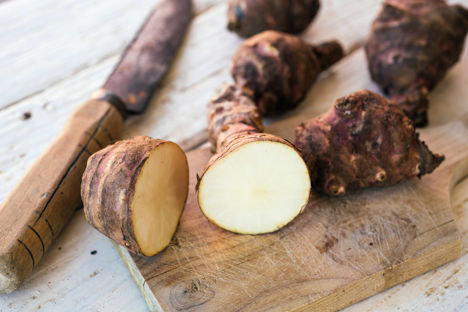
Ingredient focus: Jerusalem artichoke
A tasty (and healthier) alternative to potato, Sally Abé tells us why and how we should all be eating Jerusalem artichokes over the winter months.
View more from this series:
Ingredient focusWhat’s in seasonNeither from Jerusalem or an actual artichoke, this strange, knobbly vegetable is in fact the tuber of the sunflower Helianthus tuberosus. Originating from America, Jerusalem artichokes were cultivated in Europe in the early 1600s. High in iron and potassium, they’re a very healthy vegetable and good for diabetics due to their low glycemic index and low starch levels, making them a lower calorie alternative to potato. The only downside is the high levels of inulin Jerusalem artichokes contain, which the body's digestive enzymes cannot break down. This job gets left to bacteria in the gut, turning it into CO2. This can result in excess gas in some people; a little embarrassing at a dinner party!
Jerusalem artichokes are in season throughout the winter months in the UK, and can be found either as topinambour, which have a reddish purple skin with lots of knobbly bits, or as helianthus, which are a pale beige and normally straighter and therefore easier to peel. When peeling prior to cooking it is advisable to keep the Jerusalem artichokes in acidulated water to prevent them from discolouring. It is not, however, mandatory to peel them; just make sure you give them a good scrub first.
When you're looking for Jerusalem artichokes in the shops, make sure they're nice and firm – anything soft is old and should be left alone. It's worth avoiding especially knobbly specimens as they're harder to clean or peel.
Cooking with Jerusalem artichokes
As they are high in fructose, Jerusalem artichokes are quite sweet to the taste, much more than that of potato and with long, slow cooking this sweetness is released even further when it begins to caramelize. Jerusalem artichokes have a versatile, nutty, earthy flavour and taste not too dissimilar to globe artichokes and salsify.
This versatility makes them a huge favourite with chefs. Jerusalem artichokes are best friends with herbs and spices: rosemary, bay, parsley and pepper, cardamom and nutmeg are the best flavours to add to soups, salads and risottos. They also go hand in hand with citrus, especially the peel; try grating some onto baked Jerusalem artichokes.
Jerusalem artichokes pair well with red meats such as beef and lamb, but also stand up to much stronger game birds such as grouse and woodcock. Artichokes are at their peak during the game season, so the two make natural bedfellows, as shown by Andy McLeish with his wonderful roast wood pigeon and roasted artichoke recipe. Matt Tomkinson serves a luxurious Jerusalem artichoke gratin alongside a piece of Dexter beef, but artichoke is just as able as an accompaniment to fish – check out Mark Dodson's sea bass with Jerusalem artichoke, or Shay Cooper's hazelnut-crusted brill dish.
Having a good Jerusalem artichoke purée up your sleeve is essential if you're planning on entertaining some friends over winter. Check out Richard Corrigan's in his roasted lamb rump with salsify recipe, or Tommy Banks' version made with yogurt.
They are just as delicious eaten as the star of a dish, too. Stephen Crane's timeless Jerusalem artichoke soup is something we always make when we first see the knobbly tubers on the shelves, but you can twist things up with Chantelle Nicholson's caramelised Jerusalem artichoke soup, with burnt pear and walnut. Luke Holder makes artichokes the star of the show with his Jerusalem artichoke jacket potatoes, first roasting the tuber, then scooping out the flesh and deep-frying the skins until crisp. In fact, Jerusalem artichokes make great crisps – Robin Gill uses a similar tactic to make his incredible Jerusalem artichoke, truffled brie and honey canapés, using a mandoline to shave the artichoke into thin slices before deep-frying and dusting in cep powder.
As well as standing up well to roasting, pan-roasting, boiling and steaming, you can also eat Jerusalem artichokes raw – they have a crisp, clean flavour and a texture similar to that of water chestnuts.


